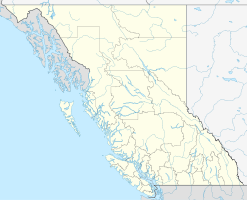Fisgard Lighthouse
| Fisgard Lighthouse | ||
|---|---|---|
| Place: | Esquimalt | |
| Location: | British Columbia , Canada | |
| Geographical location: | 48 ° 25 '49.4 " N , 123 ° 26' 51.3" W | |
| Fire carrier height : | 14.6 m | |
| Fire height : | 21.6 m | |
|
|
||
| Identifier : | Iso.WR.4s | |
| Operating mode: | automatic (since 1929) | |
| Construction time: | 1859-1860 | |
| Operating time: | since November 16, 1860 | |
| International ordinal number: | G5306 | |
The National Historic Site of Canada Fisgard Lighthouse is located, along with the National Historic Site of Canada Fort Rodd Hill , at the entrance to the Esquimalt naval port on Vancouver Island . The two structures were built to access and protect the port, today's CFB Esquimalt .
location
Fisgard Lighthouse is located in Colwood in the Capital Regional District . The lighthouse is on a headland below Fort Rodd Hill, on the western side of the entrance to the harbor. The entire property consists of the actual lighthouse, painted white, and a red two-storey caretaker's house. There is also a small boathouse.
history
Fisgard Lighthouse was declared a National Historic Site of Canada on November 3, 1958 .
The tower was built between 1859 and 1860, making it the first beacon on the west coast of what was then the British colony of Vancouver Island . The port was an important base for the Royal Navy Pacific Squadron at the time . The main components of the system were brought from England together with the first lighthouse keeper, George Davies. According to a local legend, not only were the lens and the actual equipment for the lighthouse brought from Europe, but the building blocks were also brought along as ballast. However, this legend does not correspond to reality. The building materials were sourced locally, while the steel lighthouse staircase was made in San Francisco.
The lighthouse was operated by a keeper until 1929, but then it was automated. The last guard before the automation no longer lived in the guard's house by the tower, but on the other side of the port entrance. In 1940 the light was switched to electrical operation. Since it was built, the beacon has stood on a small island at the edge of the port approach. In 1958 this changed and the small island became a headland. For this purpose, the Canadian army built an approximately 5-meter-wide dam from the mainland to the tower using various small islands and rocks.
The beacon is still in operation today and is recorded on the relevant nautical charts.
tourism
The entire facility can basically be visited today. Although not all rooms can be entered, a good view of the property can be gained in the entirety of the open rooms. The two historical monuments Fisgard Lighthouse and Fort Rodd Hill are jointly managed by Parks Canada . As part of this overall use, cultural events such as concerts and shows also take place on the site.
In the 2017/2018 reporting period, the facility with both properties had a total of 98,392 visitors.
See also
Web links
- Fisgard Lighthouse . In: BC Geographical Names (English)
- Fisgard Lighthouse Historical Site private website
Individual evidence
- ^ Fisgard Lighthouse National Historic Site of Canada. In: Canadian Register of Historic Places. Retrieved October 8, 2012 .
- ↑ Fort Rodd Hill and Fisgard Lighthouse . In: Parks Canada , accessed June 29, 2012
- ↑ Parks Canada Attendance 2017-18. (PDF; 187.08 KB) Parks Canada, accessed on July 27, 2019 (English).

